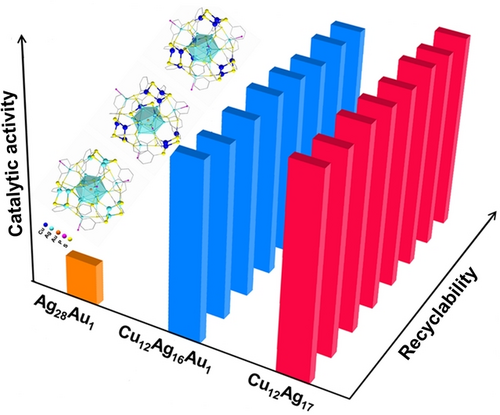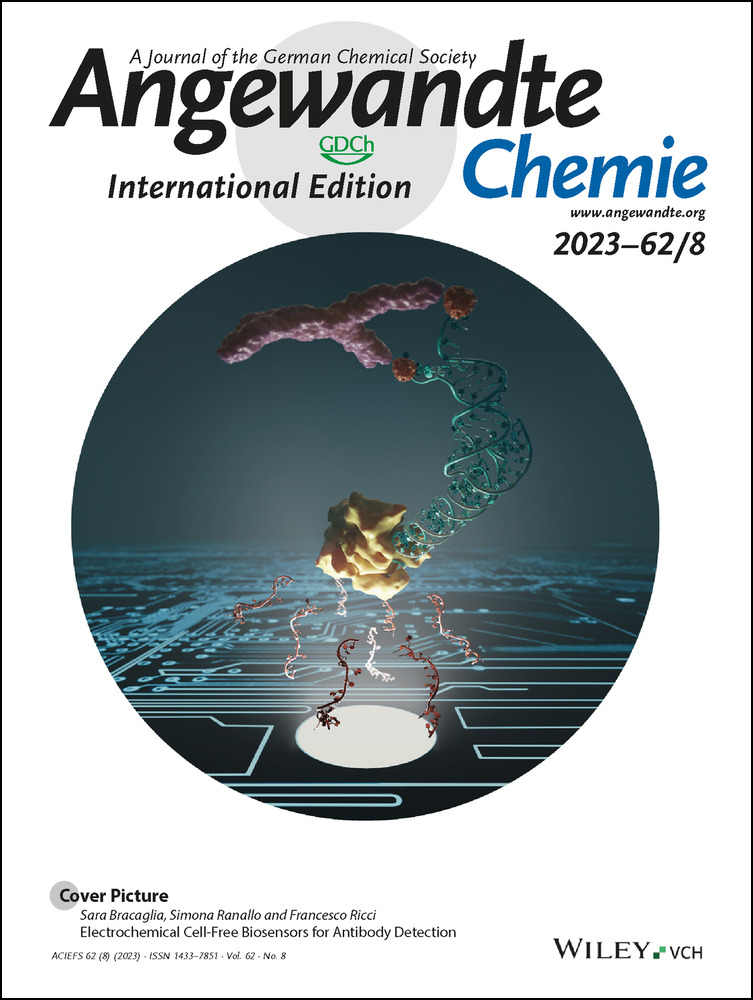Reactivity and Recyclability of Ligand-Protected Metal Cluster Catalysts for CO2 Transformation
Guangjun Li
Key Lab of Mesoscopic Chemistry of MOE and Jiangsu Key Lab of Vehicle Emissions Control, School of Chemistry and Chemical Engineering, Nanjing University, Nanjing, 210093 China
These authors contributed equally to this work.
Search for more papers by this authorJun Hou
Center for Green Innovation, School of Materials Science and Engineering, University of Science and Technology Beijing, Beijing, 100083 China
These authors contributed equally to this work.
Search for more papers by this authorXiaomei Lei
Key Laboratory of Green Chemistry and Technology, College of Chemistry, Sichuan University, Chengdu, 610064 China
Search for more papers by this authorCorresponding Author
Prof. Dan Li
Key Laboratory of Green Chemistry and Technology, College of Chemistry, Sichuan University, Chengdu, 610064 China
Search for more papers by this authorEnqi Yu
Key Lab of Mesoscopic Chemistry of MOE and Jiangsu Key Lab of Vehicle Emissions Control, School of Chemistry and Chemical Engineering, Nanjing University, Nanjing, 210093 China
Search for more papers by this authorWeigang Hu
Key Lab of Mesoscopic Chemistry of MOE and Jiangsu Key Lab of Vehicle Emissions Control, School of Chemistry and Chemical Engineering, Nanjing University, Nanjing, 210093 China
Search for more papers by this authorXiao Cai
Key Lab of Mesoscopic Chemistry of MOE and Jiangsu Key Lab of Vehicle Emissions Control, School of Chemistry and Chemical Engineering, Nanjing University, Nanjing, 210093 China
Search for more papers by this authorXu Liu
Key Lab of Mesoscopic Chemistry of MOE and Jiangsu Key Lab of Vehicle Emissions Control, School of Chemistry and Chemical Engineering, Nanjing University, Nanjing, 210093 China
Search for more papers by this authorCorresponding Author
Prof. Mingyang Chen
Center for Green Innovation, School of Materials Science and Engineering, University of Science and Technology Beijing, Beijing, 100083 China
Search for more papers by this authorCorresponding Author
Prof. Yan Zhu
Key Lab of Mesoscopic Chemistry of MOE and Jiangsu Key Lab of Vehicle Emissions Control, School of Chemistry and Chemical Engineering, Nanjing University, Nanjing, 210093 China
Search for more papers by this authorGuangjun Li
Key Lab of Mesoscopic Chemistry of MOE and Jiangsu Key Lab of Vehicle Emissions Control, School of Chemistry and Chemical Engineering, Nanjing University, Nanjing, 210093 China
These authors contributed equally to this work.
Search for more papers by this authorJun Hou
Center for Green Innovation, School of Materials Science and Engineering, University of Science and Technology Beijing, Beijing, 100083 China
These authors contributed equally to this work.
Search for more papers by this authorXiaomei Lei
Key Laboratory of Green Chemistry and Technology, College of Chemistry, Sichuan University, Chengdu, 610064 China
Search for more papers by this authorCorresponding Author
Prof. Dan Li
Key Laboratory of Green Chemistry and Technology, College of Chemistry, Sichuan University, Chengdu, 610064 China
Search for more papers by this authorEnqi Yu
Key Lab of Mesoscopic Chemistry of MOE and Jiangsu Key Lab of Vehicle Emissions Control, School of Chemistry and Chemical Engineering, Nanjing University, Nanjing, 210093 China
Search for more papers by this authorWeigang Hu
Key Lab of Mesoscopic Chemistry of MOE and Jiangsu Key Lab of Vehicle Emissions Control, School of Chemistry and Chemical Engineering, Nanjing University, Nanjing, 210093 China
Search for more papers by this authorXiao Cai
Key Lab of Mesoscopic Chemistry of MOE and Jiangsu Key Lab of Vehicle Emissions Control, School of Chemistry and Chemical Engineering, Nanjing University, Nanjing, 210093 China
Search for more papers by this authorXu Liu
Key Lab of Mesoscopic Chemistry of MOE and Jiangsu Key Lab of Vehicle Emissions Control, School of Chemistry and Chemical Engineering, Nanjing University, Nanjing, 210093 China
Search for more papers by this authorCorresponding Author
Prof. Mingyang Chen
Center for Green Innovation, School of Materials Science and Engineering, University of Science and Technology Beijing, Beijing, 100083 China
Search for more papers by this authorCorresponding Author
Prof. Yan Zhu
Key Lab of Mesoscopic Chemistry of MOE and Jiangsu Key Lab of Vehicle Emissions Control, School of Chemistry and Chemical Engineering, Nanjing University, Nanjing, 210093 China
Search for more papers by this authorGraphical Abstract
Ligand-protected metal clusters composed of silver, gold, and copper integrate the merits of homogeneous and heterogeneous catalysts and exhibit an excellent reactivity and recyclability for CO2 formylation with secondary amines. Fundamental insights are provided into the heterogeneously catalyzed reaction and design rules are presented for preparation of metal clusters with high stability and recyclability.
Abstract
It remains a significant challenge to construct an integrated catalyst that combines advantages of homogeneous and heterogeneous catalysis with clarified mechanism and high performance. Here we show atomically precise CuAg cluster catalysts for CO2 capture and utilization, where two functional units are combined into the clusters: metal and ligand. Due to atomic resolution on total and local structures of such catalysts to be achieved, which disentangles heterogeneous imprecise systems and permits tracing the reaction processes via experiments coupled with theory, site-specific catalysis induced by metal-ligand synergy can be accurately elucidated. The CuAg cluster catalysts exhibit excellent reactivity and recyclability to forge the C−N bonding from CO2 formylation with secondary amines that can make the cluster catalysts more unique compared with typically homogeneous complexes.
Conflict of interest
The authors declare no conflict of interest.
Open Research
Data Availability Statement
The data that support the findings of this study are available in the supplementary material of this article.
Supporting Information
As a service to our authors and readers, this journal provides supporting information supplied by the authors. Such materials are peer reviewed and may be re-organized for online delivery, but are not copy-edited or typeset. Technical support issues arising from supporting information (other than missing files) should be addressed to the authors.
| Filename | Description |
|---|---|
| anie202216735-sup-0001-misc_information.pdf2.8 MB | Supporting Information |
Please note: The publisher is not responsible for the content or functionality of any supporting information supplied by the authors. Any queries (other than missing content) should be directed to the corresponding author for the article.
References
- 1X. Cui, W. Li, P. Ryabchuk, K. Junge, M. Beller, Nat. Catal. 2018, 1, 385–397.
- 2L. Liu, A. Corma, Chem. Rev. 2018, 118, 4981–5079.
- 3A. Wang, J. Li, T. Zhang, Nat. Chem. Rev. 2018, 2, 65–81.
- 4M. Shen, C. Yu, H. Guan, X. Dong, C. Harris, Z. Xiao, Z. Yin, M. Muzzio, H. Lin, J. R. Robinson, V. L. Colvin, S. Sun, J. Am. Chem. Soc. 2021, 143, 2115–2122.
- 5W. Xie, J. Xu, J. Chen, H. Wang, P. Hu, Acc. Chem. Res. 2022, 55, 1237–1248.
- 6P. Liu, R. Qin, G. Fu, N. Zheng, J. Am. Chem. Soc. 2017, 139, 2122–2131.
- 7C. Xie, Z. Niu, D. Kim, M. Li, P. Yang, Chem. Rev. 2020, 120, 1184–1249.
- 8Y. Wu, D. Wang, Y. Li, Chem. Soc. Rev. 2014, 43, 2112–2124.
- 9S. Mitchell, R. Qin, N. Zheng, J. Pérez-Ramírez, Nat. Nanotechnol. 2021, 16, 129–139.
- 10C. Dong, Z. Gao, Y. Li, M. Peng, M. Wang, Y. Xu, C. Li, M. Xu, Y. Deng, X. Qin, F. Huang, X. Wei, Y. Wang, H. Liu, W. Zhou, D. Ma, Nat. Catal. 2022, 5, 485–493.
- 11J. S. Anderson, J. Rittle, J. C. Peter, Nature 2013, 501, 84–87.
- 12J. A. Terrett, J. D. Cuthbertson, V. W. Shurtleff, D. W. C. MacMillan, Nature 2015, 524, 330–334.
- 13D. M. Hood, R. A. Johnson, A. E. Carpenter, J. M. Younker, D. J. Vinyard, G. G. Stanley, Science 2020, 367, 542–548.
- 14T. G. Saint-Denis, R. Zhu, G. Chen, Q. Wu, J. Q. Yu, Science 2018, 359, 759.
- 15A. C. Deacy, A. F. R. Kilpatrick, A. Regoutz, C. K. Williams, Nat. Chem. 2020, 12, 372–380.
- 16S. Sandra Hübner, J. G. de Vries, V. Farina, Adv. Synth. Catal. 2016, 358, 3–25.
- 17P. D. Jadzinsky, G. Calero, C. J. Ackerson, D. A. Bushnell, R. D. Kornberg, Science 2007, 318, 430–433.
- 18M. Zhu, C. M. Aikens, F. J. Hollander, G. C. Schatz, R. Jin, J. Am. Chem. Soc. 2008, 130, 5883–5885.
- 19A. Desireddy, B. E. Conn, J. Guo, B. Yoon, R. N. Barnett, B. M. Monahan, K. Kirschbaum, W. P. Griffith, R. L. Whetten, U. Landman, T. P. Bigioni, Nature 2013, 501, 399–402.
- 20M. R. Narouz, K. M. Osten, P. J. Unsworth, R. W. Y. Man, K. Salorinne, S. Takano, R. Tomihara, S. Kaappa, S. Malola, C. T. Dinh, J. D. Padmos, K. Ayoo, P. J. Garrett, M. Nambo, J. H. Horton, E. H. Sargent, H. Hakkinen, T. Tsukuda, C. M. Crudden, Nat. Chem. 2019, 11, 419–425.
- 21S. Yuan, C. Xu, J. Li, Q. Wang, Angew. Chem. Int. Ed. 2019, 58, 5906–5909; Angew. Chem. 2019, 131, 5967–5970.
- 22H. Seong, V. Efremov, G. Park, H. Kim, J. S. Yoo, D. Lee, Angew. Chem. Int. Ed. 2021, 60, 14563–14570; Angew. Chem. 2021, 133, 14684–14691.
- 23S. Witzel, A. S. K. Hashmi, J. Xie, Chem. Rev. 2021, 121, 8868–8925.
- 24Z. H. Gao, K. Wei, T. Wu, J. Dong, D. E. Jiang, S. Sun, L. S. Wang, J. Am. Chem. Soc. 2022, 144, 5258–5262.
- 25M. Cao, R. Pang, Q. Wang, Z. Han, Z. Wang, X. Dong, S. Li, S. Zang, T. C. W. Mak, J. Am. Chem. Soc. 2019, 141, 14505–14509.
- 26X. Cai, W. Hu, S. Xu, D. Yang, M. Chen, M. Shu, R. Si, W. Ding, Y. Zhu, J. Am. Chem. Soc. 2020, 142, 4141–4153.
- 27R. Jin, G. Li, S. Sharma, Y. Li, X. Du, Chem. Rev. 2021, 121, 567–648.
- 28Y. Du, H. Sheng, D. Astruc, M. Zhu, Chem. Rev. 2020, 120, 526–622.
- 29G. Li, W. Hu, Y. Sun, J. Xu, X. Cai, X. Cheng, Y. Zhang, A. Tang, X. Liu, M. Chen, W. Ding, Y. Zhu, Angew. Chem. Int. Ed. 2020, 59, 21135–21142; Angew. Chem. 2020, 132, 21321–21328.
- 30G. Li, X. Sui, X. Cai, W. Hu, X. Liu, M. Chen, Y. Zhu, Angew. Chem. Int. Ed. 2021, 60, 10573–10576; Angew. Chem. 2021, 133, 10667–10670.
- 31X. Kang, H. Abroshan, S. Wang, M. Zhu, Inorg. Chem. 2019, 58, 11000–11009.
- 32G. Soldan, M. A. Aljuhani, M. S. Bootharaju, L. G. Abdul Halim, M. R. Parida, A. H. Emwas, O. F. Mohammed, O. M. Bakr, Angew. Chem. Int. Ed. 2016, 55, 5749–5753; Angew. Chem. 2016, 128, 5843–5847.
- 33D. R. Kauffman, D. Alfonso, C. Matranga, H. Qian, R. Jin, J. Phys. Chem. C 2013, 117, 7914–7923.
- 34K. Hadjiivanov, H. Knözinger, J. Phys. Chem. B 1998, 102, 10936–10940.
- 35Z. Qu, W. Huang, M. Cheng, X. Bao, J. Phys. Chem. B 2005, 109, 15842–15848.
- 36I. A. Fisher, A. T. Bell, J. Catal. 1998, 178, 153–173.
- 37K. Hadjiivanova, H. Knözinger, Phys. Chem. Chem. Phys. 2001, 3, 1132–1137.
- 38E. D. Voronova, I. E. Golub, A. Pavlov, N. V. Belkova, O. A. Filippov, L. M. Epstein, E. S. Shubina, Inorg. Chem. 2020, 59, 12240–12251.
- 39P. T. K. Lee, L. Rosenberg, Dalton Trans. 2017, 46, 8818–8826.
- 40Y. Zhai, S. S. C. Chuang, Energy Technol. 2017, 5, 510–519.
- 41Z. Bacsik, N. Hedin, Vib. Spectrosc. 2016, 87, 215–221.
- 42B. C. Smith, Spectroscopy 2018, 33, 14–20.
- 43U. Tumuluri, M. Isenberg, C. S. Tan, S. S. C. Chuang, Langmuir 2014, 30, 7405–7413.





